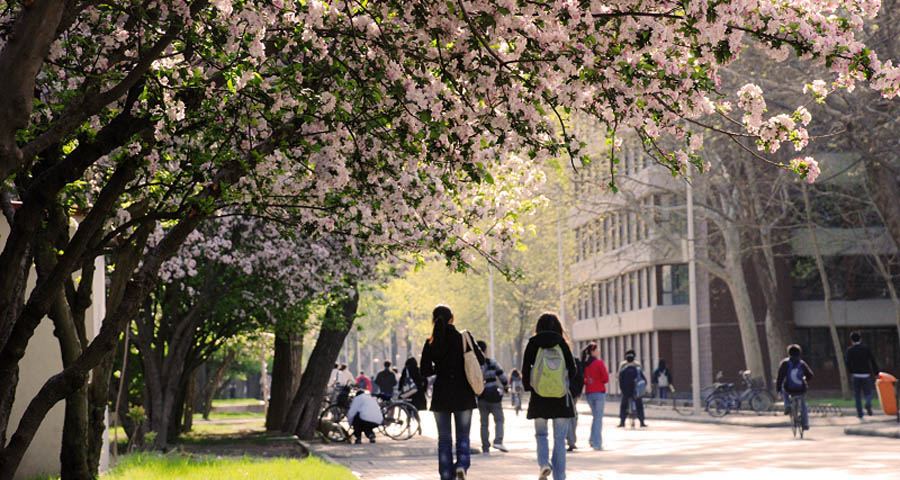Education was one of the key subjects of nationwide concern and therefore featured prominently during this year’s Two Sessions. The most discussed topic on higher education was the so-called “Double First-Class” initiative. As the initiative is being carried out in its second round, the priority and the underlying logic of this transformation are two areas that have been garnering interests both at home and abroad.

(Souce: foreignpolicy.com)
Since the founding of the People’s Republic of China (PRC), it has been the country’s unwavering mission to develop higher education and train high-level talents for the advancement of domestic industries. However, due to limited educational resources, not all colleges received supplementary support from the government. However, the launch of “Project 211” and “Project 985” in the 1990s boosted the overall academic advancement and competitiveness of domestic colleges and narrowed the gap between China and the world’s leading countries in higher education.
Project 211 is a national program that focuses on helping develop approximately 100 higher education institutions and a number of key disciplines with better academic quality for the 21st century. Officially launched in 1995, the program eventually included 112 higher education institutions. In 2017, the 112 colleges and universities of Project 211 were included in the first round of the Double First-Class initiative to build world-class universities and disciplines. Project 985, which includes 39 colleges and universities, acquired its name from the month and year (May 1998) when former President Jiang Zemin said at the 100th anniversary of Peking University that “to achieve modernization, China should have world-class universities.”
In the past 20 years, the Chinese higher education system has made remarkable achievements. Universities have made improvements both in terms of hardware: infrastructure and scale, and software: faculty building, research output, talent training, and international exchanges and cooperation. Significantly, many top-class universities around the world use the status of Project 211 and/or Project 985 universities as a criterion for potential partnership and student admission. Over the past few years, the central government has provided a total of 15.2 billion RMB (about 2.4 billion US dollars at current exchange rates) for Project 211 and 70.7 billion RMB (about 11.2 billion US dollars) for Project 985. Despite the huge financial input by the government, higher education in China still faces many challenges, including a shortage of quality educational resources, an imbalance in regional structure, and a lack of equality and diversity on the supply side.
Forty years of reform and opening-up has made China the second-largest economy in the world and boosted its higher education to the largest scale worldwide. With the implementation of Project 211 and Project 985, especially the continuation of enrollment expansion, a tendency appeared where Chinese universities strived to enlarge their scale and include as many disciplines as they could. Almost all higher education institutions were launching science, technology, agriculture, medicine, humanities, and social science programs. If the establishment of China’s mono-technic colleges in the 1950s reflected historical limitations, then the headlong rush toward comprehensive universities has been the biggest fault line in higher education over the past 20 years.
Scale is not equivalent to strength just as comprehensiveness is not equivalent to quality. An important sign that a country’s higher education has truly evolved from being large to being strong is its possession of a considerable number of globally recognized and influential universities and disciplines. Considering the limited financial resources of China and the varying degrees of priority given to higher education in different regions, national policy guidance and investment promotion must be established. To solve the existing problems, China must adopt a new perspective to deepen the comprehensive reform of higher education and explore new paths for the building of world-class universities and disciplines.
In October 2015, the State Council issued the Overall Plan for Coordinately Advancing the Construction of World First-Class Universities and First-Class Disciplines. According to this plan, key projects such as Project 211 and Project 985 were to be integrated into the Double First-Class initiative. In January 2017, the Ministry of Education, the Ministry of Finance, and the National Development and Reform Commission released the Measures for the Implementation of the Overall Scheme for Promoting the Development of World-class Universities and Disciplines. The Double First-Class List of 140 universities and 465 disciplines was established in September of the same year. The initiative attached greater importance to the differentiated and intensive development of universities. The be-all and end-all of such development was the construction of outstanding disciplines. A university that possesses world-class disciplines could be considered a first-class university. The key was no longer the number of disciplines that the university has. Apart from Project 211 and Project 985 universities and colleges, only two of the universities included in the first round of Double First-Class were comprehensive universities, while the remaining 23 were mono-technic colleges with special characteristics.

(Souce: pepperdine-graphic.com)
Unlike in the past, Double First-Class places more emphasis on the intensive development of quality higher education. For example, the application system that determines Double First-Class universities is replaced with a process-focused and result-oriented selection system that considers not just the self-evaluation and “self-claimed achievements” of an institution but also the measures it employs in talent training, scientific research, social services, and international cooperation as well as the corresponding effects it attained.
The new selection system highlights talent training and institutional innovation while downplaying the significance of the number of enrollees and papers published. International cooperation is evaluated based on whether the cooperation involves leading universities or disciplines. Other indicators include the efficiency in using national and local finances. Even if a university is not yet leading in its general strength, it still has a chance to distinguish itself in one or more disciplines. For example, a university that specializes in traditional Chinese medicine may partner with Western medical colleges through joint research, student exchanges, and academic summer/winter camps.
In other words, compared with the first round of the Double First-Class initiative, the second round emphasizes disciplinary construction and its alignment with the development needs of the nation. This round aims to establish an eco-system in which universities can develop along the lines of their own academic strengths and obtain corresponding support and evaluation. This way, the existing problems and improvement measures in the first round of the initiative are addressed. Moreover, the Ministry of Education stated that one of the major tasks for 2022 was to “gradually bring what had been done in the first round to a stop to identify or designate first-class universities and first-class disciplines.” This has great implications for Chinese universities.
The Double First-Class initiative improves the implementation of Project 211 and Project 985 by abandoning the permanent membership system, making the list of Double First-Class universities a fluid one. However, a distinction between first-class universities and universities with first-class disciplines still exists. First-class universities are further divided into two categories, with 36 universities being placed in category A, whereas six others in category B. The problem was that this official categorization became a benchmark for judging a university’s status. Some employers even used this categorization as a prerequisite for recruitment, regardless of the new recruits’ actual capabilities. As a result, unfortunately, some universities started blindly pursuing the labels of “first-class university” or “university with first-class discipline.”
Shortly after the launch of Double First-Class, some universities stopped offering courses that were important academically but that they did not do well. Also, some basic disciplines that were of fundamental significance to the country’s development were overlooked. In the meantime, however, some others made chemistry, material science, and biology, which were listed as first-class disciplines, their key disciplines. Some even rushed to establish medical schools. The underlying reason for these moves, as a specialist in higher education reform pointed out, was that it was easier to get papers published in those disciplines.
The issuance of the Opinions on Furthering the Construction of World-Class Universities and First-Class Disciplines at the 23rd meeting of the Central Committee for Comprehensively Deepening Reforms Commission in late 2021 marked the commencement of the second round of the Double First-Class initiative. The document listed the successes and failures of the previous round and emphasized the goal to “strengthen discipline-building and reduce the undue pursuit of the superficial first-class label.” As for discipline construction, the document laid out the demand-led requirement: to think and act according to the country’s urgent needs, serve the development strategies of the nation, and target technological frontiers and key areas. Specifically, the higher education sector was called on to strengthen basic disciplines, enhance applied disciplines, and promote interdisciplinary integration.
In terms of the evaluation system, the core purpose was to guide universities to effectively direct their efforts and attention to disciplinary development, innovation, and substantial breakthroughs in relevant academic research fields, to focus on the training of innovative talents, and to create world-class universities in real sense.
All in all, the new round of Double First-Class focuses on the positioning, disciplinary characteristics, and the level of academic development of the universities. To meet the national development demands, Double First-Class universities need to achieve major breakthroughs either in original innovation in the fields of natural science or in carrying forward traditional culture and exploring new dimensions of studies on governance, or both. This way, the universities will create more platforms for students to study, practice, and carry out research and provide graduates with more opportunities to pursue further education or a professional career.
As a key initiative in China’s higher education reform, Double First-Class not only undertakes the mission of talent training but also prepares the ground for innovation and social progress. Over the past two years, the COVID-19 pandemic and the turbulent international situation that followed had posed great challenges to China’s economy and employment market. As a result, college graduates were having a harder time finding jobs. At present, we are at a point where there are “more graduates than jobs.” Nevertheless, the greater the challenges, the more important it is for educational institutions to stay focused on fulfilling their fundamental and pioneering role. The Double First-Class initiative relies not only on the government’s endorsement but also on social support, especially the coordinated efforts of university leaders, professors, teachers, and students.

(Source: unischolarz.com)
Although much remains to be done, Double First-Class universities lead their peers in terms of quality faculty members and students, talent training, financial preparedness, and social recognition. This is why their graduates enjoy more opportunities for further education and career development.
The Chinese government has recently taken a series of measures to alleviate the employment pressure on college graduates, such as expanding the postgraduate enrollment, helping college graduates start their own businesses, organizing student innovation and entrepreneurship competitions, as well as job fairs. Also, as part of the effort to promote the “dual circulation” concept in the country’s economic development and build a new socialist countryside, China is refocusing on restructuring its industrial bases to create more employment opportunities for college graduates.
The promotion of the Double First-Class initiative also offers better opportunities for further people-to-people exchanges between China and other countries. To achieve a “world-class” standing and improve international competitiveness, a university must open up and carry out high-level exchanges and cooperation with its global peers. China’s first-class universities should not only team up with educational and research institutions in developed countries but also integrate into the Belt and Road Initiative and other national strategies.
With a focus on enhancing international competitiveness and influence, these universities need to create a favorable environment for substantive cooperation with world-class universities and institutes and actively participate in key regional and global research projects. They should tap into high-quality international resources for technology and education and seek new breakthroughs in promoting the intensive development of cultural exchanges between China and foreign countries, jointly training high-caliber talents with a global vision and cross-cultural communication skills, and encouraging international students to pursue degrees in China.